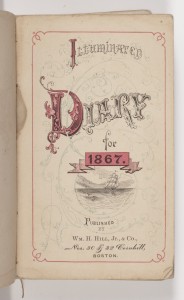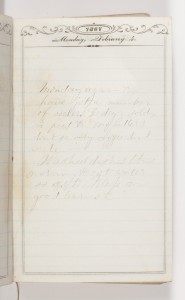Last week we featured a post by former AAS intern Lucia Ferguson (Smith College) about her journey into an unidentified diary. Read on to learn more about the diarist’s day to day life as he recorded it in his diary.
 During 1867, when he kept this diary, Henry made his living by selling pictures and books, working at a local goldmine, quarrying stone, and helping at an uncle’s farm. He writes at least a few words every day, primarily of his activities selling “pictures” and books through subscription, his work, his travels to nearby towns to visit friends and relatives, and his correspondence.
During 1867, when he kept this diary, Henry made his living by selling pictures and books, working at a local goldmine, quarrying stone, and helping at an uncle’s farm. He writes at least a few words every day, primarily of his activities selling “pictures” and books through subscription, his work, his travels to nearby towns to visit friends and relatives, and his correspondence.
He often records the names of his customers and his prices, as well as his own purchases (mainly books). His pictures seem to consist of landscapes and portraits of celebrated Civil War heroes such as Abraham Lincoln and General James Shields. It is unclear whether he creates them himself or if they are prints of some kind. However, he does once mention “painting in the morning,” so he may well have painted all the images himself.
Henry attends church regularly, as well as a few Sunday schools and “sings.” He also goes to a town meeting, a temperance meeting, plays, and lectures. A handful of times he mentions himself or his family having their photographs taken. I wish I knew where to find those pictures, if they still exist.
Henry travels regularly to nearby towns such as Lyndeborough, Peterborough, Wilton, Weare, New Ipswich, New Boston, and Nashua. He often writes of letters from Lizzie, his future wife, and from “Benjamin F,” probably his cousin Benjamin Franklin Martin (1837-1908). It is difficult to tell in which town his boarding-house is located; his family home is possibly in Bennington, although his wedding announcement lists him as “of Wilton,” several siblings were born in Francestown, and his parents will move to Rindge within a few years. He writes of friends by the names of Frank, Pendleton, Albert, and Henry F, and a fellow mine worker named Jim. He has an antagonistic relationship with another miner named Saul Tilton, who owes the diarist money and skips town without paying him (after behaving oddly for a few days and falling asleep in the blacksmith’s shop).
Monday again etc / have got a number of orders today sold 2 pict etc no letters / dont se [sic] why Lizzie dont write— / Washed dishes this morning & got water so as to Bless on good terms etc. (Monday, February 4th)
This young woman named Lizzie appears frequently, mostly acknowledged through the receipt of letters, but also occasionally physical visits. Once I thought I had found a candidate for the diarist, I wondered if he had actually married his sweetheart, and having little else to look for (no last names and so on) I used her to narrow the search. Sure enough, of all the Henrys who married Lizzies in Hillsborough County in the early 1870s, this diarist was one.
Her name was Elizabeth B. Hadley, eldest daughter of Wilkes and Betsey F. Hadley, and she married Henry in Wilton on September 11, 1869. The newlyweds resided for some time in Amherst, New Hampshire, with Henry’s younger brother Levi. As far as I can tell they had only one child, a daughter born in 1871 named Minnie.
The impression of a flower stain remains on September 19: “this flower L– put here,” underneath which Lizzie added, in her delicate curling hand, “Goodly for a while”
Check back next week to read about Henry’s life as a soldier and a miner!


One thought on “Indentifying the Unidentified, Part II”